Space-Wars: Mapping the Aesthetics of Post-Cinematic City Space in Action Films and Video Games
By Matthias Stork
The aesthetics of the city constitute an integral part of the mainstream action film. A genre cornerstone, the city’s hard-edged environment of concrete urbanism functions as a site for violent spectacle. It is an action-centric space. Typically, the city’s iconographic structure serves as spatial backdrop for effects-driven choreography that emphasizes the materiality of an action body, be it technological or physical.1
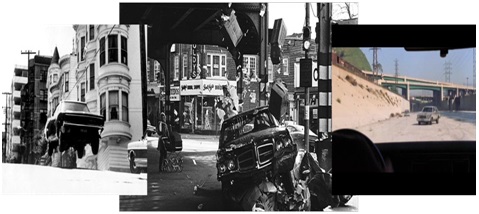
Famous car chases from Bullitt (1968, dir. Peter Yates), The French Connection (1971, dir. William Friedkin), and To Live and Die in LA (1985, dir. William Friedkin)

The jump n’run film, exemplified by the Parkour action in District B-13 (2004, dir. Pierre Morel)
The most pertinent paradigms include the iconically rough car chase and its modern successor, the much-more embodied Parkour pursuit. In these scenarios, the city predominantly operates as an obstacle course; a cultural scenery; a playing field. In the wake of September 11, however, the city’s generic construct has assumed far-reaching allegorical and socio-political value. It has come to represent a national – a specifically American – identity, brutalized by acts of terrorism, subjected to chaos and uncertainty. This is most explicitly conveyed in Christopher Nolan’s post-millenial Batman franchise (Batman Begins, The Dark Knight, The Dark Knight Rises) which proposes Gotham city as the quintessential post-9/11 cityscape. The trilogy stages the defense of Gotham as a symbolic act to re-gain control in an era increasingly defined by the loss of control.
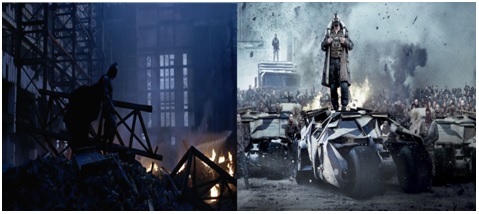
The city as battle site in the terrorism-infested dystopia of The Dark Knight (2007, dir. Christopher Nolan) & The Dark Knight Rises (2012, dir. Christopher Nolan)
The notion of control indeed permeates the fabric of today’s cinematic action city. Since the early 21st century, films have constructed urban space as a Foucauldian entity. Panopticon-like spheres of surveillance rigorously record and discipline the city’s technological ecosystem while a multitude of computer screens and virtual displays define its techno-iconography. The city, as seen through these devices, registers as a mediated space. Its spatial dimensions are no longer posited as real. Rather, they are revealed as products of a spatialized media framework. The modern cityscape of the action film thereby offers a microcosmic view of our contemporary mediascape.
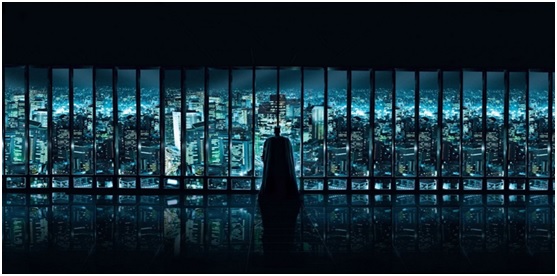
Promotional image invoking the visual eye of surveillance in The Dark Knight
The self-reflexive character of the city as mediated space is referenced in the newest James Bond film Skyfall (2012, dir. Sam Mendes). The film’s portrayal of space in relation to geo-political terror posits the city as a digitally coded system, a global data network that facilitates access, control/navigability, and manipulation. This vision of the city as code embodies what Steven Shaviro describes as the “new social logic of spatialization”,2 a reformulation of Frederic Jameson’s postmodern postulate that culture is “increasingly dominated by space and spatial logic.”3
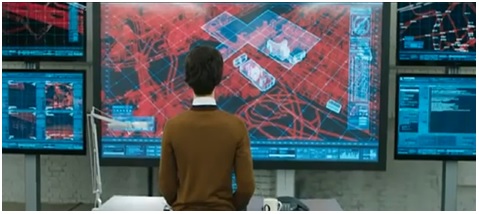
A data display network in the 23rd James Bond adventure Skyfall (2012, dir. Sam Mendes)
Skyfall’s plot is organized around the dichotomy of digital and analogue space, the state of being caught in a controlled grid or to remain unobserved, off-the-grid. But the film enacts another key element of the contemporary socio-cultural climate: the element of play. The villain, Raoul Silva, continuously exploits the city’s (or, the world’s) universal code as gamespace, controlling or mis-controlling the data of an almost completely malleable space. In this regard, Skyfall reflects gamic structure to articulate current politics of control in urban space. Other action films of the past year have channeled video game aesthetics even more explicitly, shifting our understanding of the cinematically presented city. This essay examines this shift in an attempt to map the aesthetics of a post-cinematic city space.
Perverse digital gaming: the terrorist play with global and local data as inter-national threat
The relationship between films and video games is generally framed as a history of economic synergy, referencing film-to-video game adaptations, marketing tie-ins, and, more recently, transmedia storytelling across multiple platforms.4 More specifically, however, the film-game duality needs to be conceptualized as a process of remediation, the continual exchange of distinct aesthetic properties. Video games have borrowed heavily from cinema’s visual grammar to present their worlds to players, from camera movements to subjective shots and varied perspectives. Essentially, games employ cinema as a cultural interface to reveal and explore their distinctive construction of space. Cinematic techniques basically enable players to look at and move through gamic worlds. By the same token, films have early on shown an interest in producing cinematic versions of gamespace.
The opening, in particular, juxtaposes film and video game aesthetics via split screen
1982’s Tron (dir. Steven Lisberger), an action-adventure conceptually inspired by the flat electronic surface of the video game Pong (1972, Atari), marks one of the first instances of cinema’s attempt to explore the still abstract popular notion of cyber- or computer space, mixing early computer animation with live action footage.
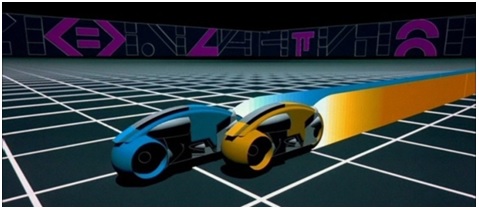
Tron’s computer space, an homage to the pre-digital arcade
Yet, Tron’s presentation of space, though visually remarkable, merely provides an interpretation rather than a replication of gamespace. While its diegetic world was clearly informed by the immaterial sphere of the rising information age, its overarching conceptualization of space was fairly conventional. The tendency to ground experimentation in stylistic traditionalism continues to characterize the look of most video game films today which rarely remediate the full logic of gamespace and instead offer an extravagantly updated cinematic space. Most video game adaptations are in fact just exercises in cinematic window- or house-dressing that exploit the iconic status of a franchise, replanting characters, music, and design.5 This insufficient remediation practice is not exclusively attributable to economic considerations of the quick buck, however. More likely, it involves the inherent differences between cinematic and video game spaces both of which operate under distinct forms of representation and generate specific media experiences.
Cinematic space, as defined in classical terms, is subordinated to the frame of time. As such, it is indexically grounded in a specific temporality. The space presented through cinema is thus, first and foremost, a projection of a preserved amount of time.6 Space is conceived as a continuum, one that is incomplete, though. Cinematic space is a temporally organized construct of image fragments, given depth through mise-en-scene and design and captured through varying camera angles and movements. These fragments are then assembled and revealed through montage, as a holistic space. Classical continuity editing utilizes an arsenal of match cuts to evoke a seamless and transparent space – this practice is even manifest in the amped-up post-1960s version of “intensified continuity” which equally aims to build a closed, albeit a tad more disjunctive, spatial system.7 In action cinema, this representation of space is designed to facilitate clear viewpoints that enable spectators to carefully observe and contemplate on-screen action, the spectacle of bodily and technological motion.
Video game spaces differ from cinematic space in that they privilege time and contemplation in a different fashion, more freely and interactively. Video games are not bound by temporality. Space is not presented in a continuous structure but rather gradually opened up by actions and visceral engagement. It is not only to be looked at, it is to be explored and acted upon, by players. While films are cultural objects designed to be viewed, games, as Aarseth emphasizes, are “both object and process […], they must be played.”8 Another difference between cinematic and gamic space lies in their material construction. Cinematic space is a recording whereas gamespace is a rendering, of objects, sceneries, and possible scenarios. Alexander Galloway rightfully argues that video game space is pre-constituted as a “fully rendered actionable space” that encourages the player’s interaction through spatial navigation.9 As a result, the basic syntactic element of cinematic language, montage, becomes largely superfluous and video games adopt what Lev Manovich terms true aesthetics of continuity, spatial representations uninterrupted by cuts.10 The player’s actions guide a virtual camera through a computerized space that is (almost) completely navigable, depending upon the rules of the game. In this regard, video game space transcends the cinematic, offering a digital expansion, a post-cinematic space.11
While earlier iterations of video game space relied on 2D vector graphics, contemporary commercial games largely utilize 3D modeling engines as the basis for spatial construction. Perspective, a vantage point into the space, is either channeled through a third person avatar or a first-person subjective viewpoint.
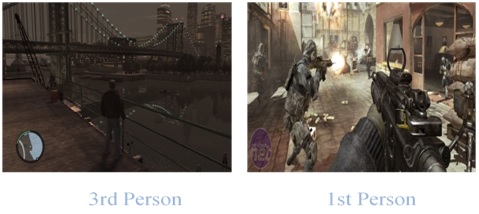
Images taken from GTA IV (2008, Rockstar Games) and Call of Duty Black Ops (2010, Activision)
All of these video game spaces tend to offer graphical interfaces as well – extra-diegetic spaces within the diegesis, particularly maps and vision enhancements such as night vision goggles or slow-motion modes. Maps generally grant players a cartographic meta-view of the entire gamespace. Ocular enhancements, meanwhile, allow for the discrete manipulation of the gamespace, as in Red Dead Redemption’s (2010, Take-Two Interactive) Dead-Eye mode that enables players to maximize shooting efficiency through slow-motion, target tagging, and color alteration. All of these are post-cinematic features.
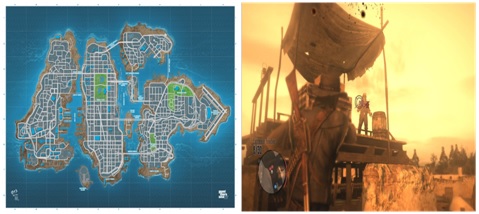
Images taken from GTA IV and Red Dead Redemption
And they demonstrate that video game space is, by its very nature, a media type, a digital creation; it is designed to be interacted with. While film viewers are presented with a fragmented space that they cognitively assemble into a whole, gamers reveal, or rather construct, gamespace through actions. They re-contextualize cinematic elements of presentation in a digital, interactive environment, thereby rendering them post-cinematic. This post-cinematic aesthetic is closely linked to the city’s inherent concept of control. While cinema cannot grant the spectator control over the representational space, games rely on the very fact that gamers are in spatial control. This notion of control, especially in relation to digital space, forms part of many recent action film and game narratives. By way of the action genre, both media indeed examine the city as a dialectical site of control and loss of control.
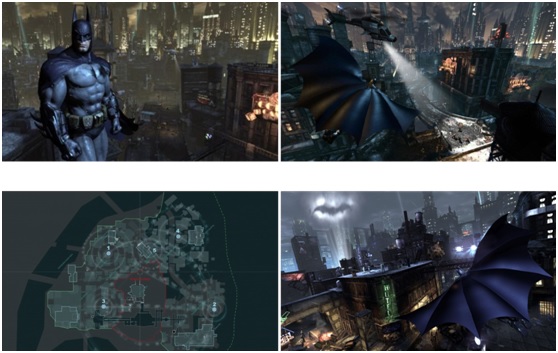
The urban space of Batman Arkham City
Batman Arkham City (2011, Warner Bros. Interactive Entertainment), for instance, is an open-world, third-person perspective action-adventure game that positions Batman as the sole crusader to re-assert control over the super-prison Arkham City. The dystopian urban space is overrun with criminals who have turned the disciplinary locale upside down. Batman’s, or the player’s, task is to contain the chaos in the city, explore and conquer the entire space, and re-establish control. The player can access a complete map – an abstract spatial representation – or follow the iconic Bat-Signal to navigate Arkham City – which is a more action-centric approach. Furthermore, the gameplay equips the player with sophisticated technology to master the city space, most importantly the built-in detective mode. While the game combines cinematic camera angles with a digitally produced continuous long take, the detective mode introduces an explicitly post-cinematic feature, the ability to manipulate or re-program space, to exert direct control over it. Employed, the mode plunges the screen in layers of blue light highlighting elements within the city space, such as character status, clues, object locations, and city-wide communications. Essentially, the player can read a version of the city’s digital code.
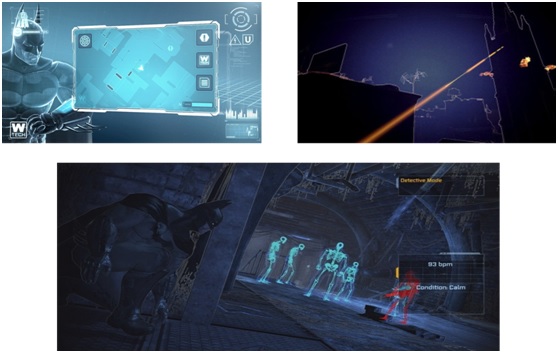
The city as code in Batman Arkham City
A similar post-cinematic technique can be observed in Crysis 2 (2011, Electronic Arts), a first-person shooter that pits a technologically-enhanced super-soldier against invading aliens in a shattered New York cityscape. The game is much more hyper-kinetic than Arkham City emphasizing the chaos of combat with the first-person camera rendering the action impactful and immediate. The city is presented impressionistically, as a flurry of computer-generated actions that transpire continuously. The player needs to navigate and conquer the space, not by exploring it, but by constantly reacting to it. Crysis 2 presents its gamespace as an overwhelming site of technological warfare. The player-character wears a super suite that facilitates a more controlled engagement with space through post-cinematic aesthetics. The suit’s properties change the space’s look, thereby heightening player perception and spatial control.
The post-cinematic super suit technology in Crysis 2
Certain action films attempt to emulate these video game aesthetics. And while traditional cinematic form proves insufficient for such an endeavor, the evolution of digital cinema has created more experimental ground for the re-contextualization of gamespace. Digitally coded cinema, by its technological basis alone, constitutes a form of post-cinema that re-conceptualizes our notion of cinematic space and brings it closer to the digital space of games and contemporary media. To a certain degree, it is equally able to emulate the video game’s use of post-cinematic space, directing a virtual camera – which adopts a machinic gaze – through a computerized spatial construct. In this context, the city has featured prominently in recent post-cinematic experiments.
An uninterrupted long take that emphasizes digital compositing as seamless spatialization
Marvel’s The Avengers (2012, dir. Joss Whedon), for example, offers a sequence in which the camera follows the heroes’ actions to re-gain control over an alien-infested New York cityscape. The uninterrupted long-take and the camera as exploring device mirror the aesthetic configuration of video game space. Similarly, Iron Man’s vision reflects the graphical interface structure known from games’ extra-diegetic space.
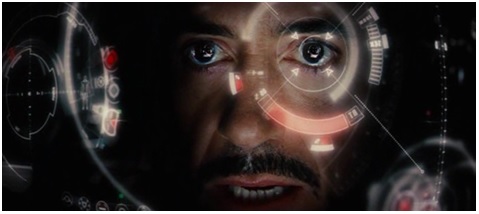
Tony Stark’s integrated interface resembles the extra-diegetic game interface
This post-cinematic view of gamespace is also evident in the films Dredd (2012, dir. Pete Travis) and Resident Evil Retribution (2012, dir. Paul W.S. Anderson), both of which employ the gamic level structure as dramatic engine. The films repeatedly anchor common genre conventions within abstract concepts of gamespace, such as cartographic networks and three-dimensionally rendered models. The regular transitions from the real into the unreal, digitized, realm of representation establish a correlation between cinematic narrative and a conceptual notion of digital space.
Juxtaposing visualizations of gamespace
In RE 5, the virtual camera over and over again moves out of the diegesis to reveal a meta- or code-view of the film’s city space. The cityscape is an artificially engineered level-space (complete with a time countdown) that is controlled by a super-computer designed to prevent the characters from navigating their way out of it. It equates control with spatial navigability and movement.
Visualizing gamespace as a computer-controlled grid
This idea of control also permeates the logic of the action chase film Premium Rush (2012, dir. David Koepp) which presents New York City through the eyes of bike messenger Wilee. While Wilee predominantly navigates the hustle-and-bustle city space on his bike, the film shows his spatial movement through the graphical interface of Google Earth’s mobile app – rendered via tilt-shift cinematography that imitates gamic isometric perspective. These post-cinematic ellipses illustrate the interconnectedness, the network structure, of today’s digitally coded urban space and illustrate that within gamespace, the push of a button can precipitate significant spatial reconfiguration. Hit enter and you are transported to a new level, basically.
The interconnectivity of space
Another post-cinematic element in Premium Rush exemplifies the multiplicity of possibility in digital gamespace, what Lev Manovich describes as contemporary database logic12. When Wilee is about to cross a busy intersection, the film pre-programs the ensuing events through his perspective. Wilee’s expert view generates potential scenarios for the crossing and he chooses the most successful one. He thus somewhat controls this dangerous spatial environment. In essence, the film pre-visualizes or pre-renders actions and their results. It stops the narrative to engage in computational activity, reading the city’s code and making decisions based upon it.
The data view, through the eyes of a code reader/generator
All of these instances illustrate how modern action films channel video game aesthetics to offer a view of post-cinematic city space. Through an engagement with the city as digital code, defined by the dialectic of control and control loss, action films reflect on the logic of the digital in our media-centric society. But while they effectively mirror the representation of gamespace, they are unable to fully implement its interactive base. To model the look of gamespace does not entail a fitting interpretation of its experience. Cinema, even post-cinema, ultimately, cannot faithfully replicate the exact experience of playing video games. Spectators cannot influence or manipulate events that occur on the screen. But by embracing post-cinematic logic, films, and action films particularly, can approximate the feel of gameplay, the navigation of chaotic, out-of-control space and the visceral involvement it generates. By consequence, many contemporary actions films do not ask viewers to contemplate the clarity and coherence of space but to react to its visceral force. Rather than offering long takes through continuous space that promise control, these films embrace an excessive use of montage. They reject video game aesthetics but they also reject classical cinematic aesthetics. Instead, they combine an array of varied shots at high-speed, breaking normative formalism in favor of the new logic of constant arbitrary action. Continuity is replaced with what Steven Shaviro terms post-continuity, the governing principle of digital post-cinema.13 And here, within this new spatial environment, what we have come to understand as cinematic space sometimes truly looks or feels like a video game.
Acknowledgements: I would like to thank Harrison Gish and James Gilmore for discussing this short piece with me.
Endnotes
- Purse, Lisa. Contemporary Action Cinema. Edinburgh: Edinburgh University Press, 2011.
- Shaviro, Steven. “Splitting the Atom: Post-Cinematic Articulations of Sound and Vision.” Forthcoming.
- Jameson, Fredric. Postmodernism, Or, The Cultural Logic of Late Capitalism. Durham: Duke University Press, 1991. 25.
- See Brookey, Robert Allen. Hollywood Gamers: Digital Convergence in the Film and Video Game Industries. Bloomington: Indiana University Press, 2010.
- For a current observation of this trend, see my video essay “Transmedia Synergies” (Mediascape Winter 2013) and Krupa, Daniel. “The Video Game Movie Rises.” IGN Movie Blog, 16 November 2012.
- See Rodowick, David. The Virtual Life of Film. Cambridge: Harvard University Press, 2007.
- Bordwell, David. The Way Hollywood Tell It: Story and Style in Modern Movies. Berkeley, Los Angeles: University of California Press, 2006. 117-157.
- Aarseth, Espen. “Computer Game Studies, Year One.” Game Studies – The International Journal of Computer Game Research. 1.1 July 2001.
- Galloway, Alexander. Gaming: Essays on Algorithmic Culture. Minneapolis: University of Minnesota Press, 2006. 63.
- Manovich, Lev. The Language of New Media. Cambridge: MIT Press, 2001. 142.
- Nitsche, Michael. Video Game Spaces: Image, Play, and Structure in 3D Game Worlds. Cambridge: MIT Press, 2008.
- Manovich 2001. 237-243.
- Shaviro, Steven. “Post-Continuity.” The Pinocchio Theory Blog. 26 March 2012.

